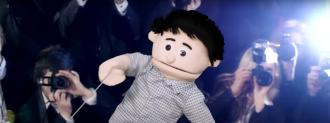With the help of AI, savvy editors can now create videos in which a real person says or does something they didn’t do.
These clips, dubbed “deepfakes,” are everywhere on the internet. Some use the likenesses of world leaders to spread disinformation, and most are pornographic and exploit nonconsenting women.
Those types of deepfakes are dangerous and despicable, but the tech can also be used to create hilarious entertainment — something the creators of South Park are doing in a new satirical web show, called Sassy Justice, featuring an all-star lineup of deepfakes of celebrities, actors, politicians.
Sassy Justice
Trey Parker and Matt Stone’s initial plan was to make a deepfake feature film with actor and voice artist Peter Serafinowicz. In early 2020, they founded a new studio for the project, Deep Voodoo, and hired about 20 deepfake artists and technicians to work on it.
“Before the big scary thing of coronavirus showed up, everyone was so afraid of deepfakes,” Stone told the New York Times. “We just wanted to make fun of it because it makes it less scary.”
Just a few days into filming, the pandemic ground everything to a halt, but rather than letting their investment go to waste, they pivoted to create Sassy Justice.
The show is structured to look like a segment for a local news station in Cheyenne, Wyoming, and during it, reporter Fred Sassy — Serafinowicz with Donald Trump’s face — investigates the dangers of deepfakes.
The 15-minute clip includes incredibly realistic-looking deepfakes of Al Gore, Ivanka Trump, and Jared Kusher. Deepfake Mark Zuckerberg makes an appearance, too, as the “Dialysis King of Cheyenne.”
Unless someone were to watch Sassy Justice with the volume muted, there’s no way these deepfakes would fool anybody — most are paired with voices that sound like South Park characters and the dialogue is absurd.
However, the deepfakes look amazing — as they should, given that the project has cost the creators millions of dollars.
“It’s probably the single most expensive YouTube video ever made,” Parker told the NYT.
Deepfakes in Entertainment
Parker and Stone aren’t the only big names in entertainment buying into deepfakes — and the tech could be destined for far bigger screens than YouTube.
Disney is developing high-resolution deepfakes, ones that could trick the eye even on theater screens and not just smartphones and laptops. Once perfected, the tech could make it easier for the company to place any actor — living or dead — into big-budget feature films.
Like all groundbreaking technologies, it’s hard to imagine what impact such deepfake tech might have on the entertainment industry.
One day, actors like Serafinowicz might build entire careers “playing” celebrities they look nothing alike. Living actors could star in movies alongside the icons of the past, and existing films could be rereleased with new leads. A-listers could appear in dozens of movies a year because they don’t actually have to shoot them.
The Downsides
The possibilities really do seem endless — and not all of the outcomes are ideal.
If A-listers can star in all of those movies, will that affect new actors’ ability to break into the industry? And what happens if an actor dies while under contract with a studio — could the studio then use their likeness in a film they never actually shot?
It’s a perfect medium for us.
Trey Parker
Those are just some of the questions the industry will need to navigate in the future.
As for Parker and Stone, they aren’t sure what their next step will be with Deep VooDoo — they might make more episodes of Sassy Justice or go back to their feature film idea — but either way, expect to see more deepfakes from the duo.
“It really is this new form of animation for people like us, who like to construct things on a shot-by-shot level and have control over every single actor and voice,” Parker said. “It’s a perfect medium for us.”
We’d love to hear from you! If you have a comment about this article or if you have a tip for a future Freethink story, please email us at [email protected].






